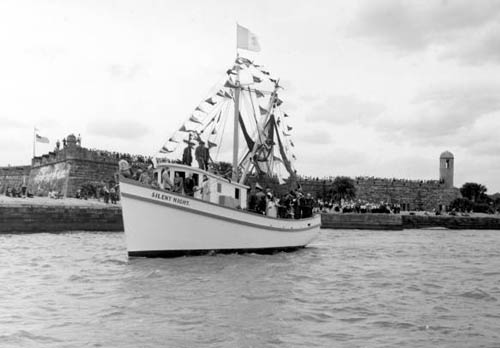The First Coast of Florida, in addition to being the first U.S. coast to be settled by Europeans, was the first coast to foster a commercial shrimping industry. Spreading from Fernandina to St. Augustine in the early 20th century, following the expansion of the railroad built by capitalist Henry Flagler, the nascent commercial shrimping and shrimpboat-building industries were dominated by a number of innovative families of Mediterranean descent–including the Versaggi, the Poli, the Salvadore, and the Xynides families.

1947 photograph of the shrimp boat Silent Night cruising before the 17th century Spanish fortification Castillo de San Marcos, taken during the annual blessing of the fleet celebration. Image courtesy of the Florida Photographic Collection, State Library and Archives of Florida.
The St. Augustine Lighthouse and Museum has taken a particular interest in saving this unique maritime heritage, and is engaging these descendant communities to help preserve and share their stories. Back in March we opened an outside exhibit focusing on St. Augustine’s shrimping history, and in July we hosted a Celebration of our Maritime Heritage and honored these families with shrimp-pink roses at a community gathering which also recognized visiting archaeologists from Flinders University in Australia, who had traveled here to study the archaeological record of America’s oldest port.
Just last Sunday, a story on the Lighthouse’s ongoing efforts to preserve the history of St. Augustine shrimping and the memories of her shrimping families appeared in the local paper, the St. Augustine Record. (click the link to read the entire article; registration is required, but its quick and easy and you’ll get no spam emails)
“These families built an industry that was instrumental in making St. Augustine a thriving commercial center and now they are helping us keep that story alive by sharing family memorabilia as well as their personal stories and memories. The vast and diverse story of the nation’s oldest port cannot be told without the histories of the shrimpers, boat builders, fishermen and others who saw the small industries they founded here grow and spread throughout the world,” said Kathleen McCormick, director of museum conservation, who is helping grow the Lighthouse & Museum shrimping exhibit/project.
This local industry quickly grew, so that by 1916 there were some 32 raw shrimp houses, 10 canneries and approximately 300 small boats pulling some type of shrimping net to meet the ever-growing demand of this bar-food turned restaurant specialty. Coastguardsmen stationed at the Lighthouse during World War II spread the taste of Florida fried shrimp throughout the entire country, cementing the widespread popularity of this dish. Local families built boats here that were used throughout Florida waters, while the Desco boatbuilding company constructed wooden shrimp boats here that were sold and utilized around the world. St. Augustine’s last commercially-built wooden shrimp boats were constructed in the early 1980s.
Our Conservator and Collections Manager Kathleen McCormick has played an instrumental role in handling our growing collection of material culture related to this industry, and in the recording of oral histories from our local maritime community. Its exciting and somewhat rare for an archaeologist to have a chance to work with a living descendant community, and refreshing to see that this kind of project has been recognized as newsworthy by the local media.

